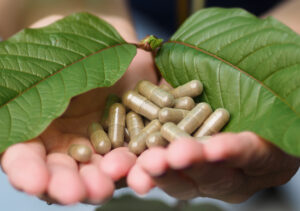Now that cannabis is rapidly becoming legal around the world, a closer look is being placed on its different components and how they could be of use.
While CBD (cannabidiol) is one cannabinoid that has been in the spotlight recently for its claimed therapeutic effects, another cannabinoid may soon topple it – CBN, or cannabinol.
We are still in the very early stages of learning about CBN (think of it as the first few seconds of a race), but there are signs it may have very useful applications, most notably for sleep.
Read on for an in-depth look at cannabinol — what it is, the science behind it, and how it could be of use.
What is CBN?
“CBN is one of the most common cannabinoids found in the cannabis plant after THC and CBD,” Dr. Michelle Ross told Greencamp. Ross is a neuroscientist that has been working in the cannabis research field since 2006, and coaches clients on personalized cannabis treatment plans with her company, Infused Health.
Cannabis is known to have over 100 different cannabinoids that you experience all in different amounts when consuming cannabis, depending on the strain. They can work synergistically together in what is known as the “entourage effect.”
Cannabinoids affect our bodies through the endocannabinoid system (ECS), which is a network of signals that regulate a range of bodily functions, from mood and pain perception to appetite and nausea.
Our body produces its own cannabinoids that attach to receptors in the ECS to signal a bodily function. However, cannabinoids from cannabis can also bind to the same receptors, which causes us to feel cannabis’ effects when consumed.
With cannabis legalization, scientists and companies have begun to take a closer look at cannabinoids, such as CBD, and how they could be used to help people.
Given that CBD has no psychoactive effects but could have medical uses, such as for epilepsy or stress, it has become an attractive option for products, and CBN could find similar success.
While CBD and THC (tetrahydrocannabinol) have been the most well researched of the cannabinoids, CBN was actually the first cannabinoid scientists isolated at the end of the 19th century. Its structure was further defined in the early 1930s and its chemical synthesis was created in 1940.
How is it created?
“[CBN] is a degradation product of THC,” said Dr. Jeremy Riggle, the chief scientist at Mary’s Medicinals, a cannabis company that produces its own CBN products.
“The plant itself doesn’t make very much of it, if any, [but] over time as THC is exposed to temperatures and sunlight, THC itself will degrade into CBN,” Dr. Riggle explained.
This process of degradation as THC is exposed to oxygen is called oxidation.
Since CBN is created as cannabis ages, it has typically been associated with old or poorly cannabis in the past, which has given it a bit of a bad rep.
In fact, CBN was found through laboratory testing to be the most present cannabinoid in perfectly preserved cannabis found in a 2,700-year-old Chinese shaman tomb. Now that’s some old cannabis.
Since CBN comes from THC, they both have a similar molecular structure – THC even has cannabinol in its name, tetrahydrocannabinol.
CBN can also be produced after cannabis is heated, a process called decarboxylation. Decarboxylation also converts THCA (tetrahydrocannabinolic acid) and CBDA (cannabidiolic acid) found in raw cannabis into cannabinoids THC and CBD.
CBN is not present in as high amounts in cannabis as THC and CBD, though. While CBD can be as high as 15-20 percent in cannabis flower, most cannabis plants contain around one percent or less of CBN, Dr. Ross said.
“There’s no CBN-rich strains,” she said. “Its presence really is from it being cured, degraded or vaporizing it. We’re not going to see over one percent CBN if it has been stored properly.”
However, it is possible to distill CBN to boost up its concentration to up to 60 percent, Dr. Riggle mentioned, much like is being done with CBD oils.
Is CBN psychoactive?
One major draw of CBD is that it is not psychoactive, allowing a product that is friendlier to regulate (the U.S. has legalized hemp-derived CBD) and easier to market to those cautious of cannabis.
However, unlike CBD, CBN has been found to be “slightly psychoactive,” according to Dr. Riggle, but much less so than THC due to its reaction with CB1 receptors in the ECS.
CB1 receptors are “what initiate the euphoric psychotropic effects [of cannabis],” Dr. Riggle said, and CBN has a low affinity for them due to its structure.
“CBN just doesn’t fit on the receptors as well as THC,” Dr. Riggle said.
Studies in the past have noted that CBN does not have a psychoactive effect.
A 1973 study observed that CBN given to six male subjects had none of the “characteristic mental or physical effects of THC,” while a study in 1980 found CBN had no “significant effect” on cognitive or motor function.
“[CBN] is not going to drive psychosis, which is actually nice because there are some people who are very sensitive to THC,” Dr. Ross said.
However, there is an indication that CBN could amplify the effects of THC.
A 1975 study on five male subjects found when CBN was taken with THC, subjects felt more “drugged, drunk, dizzy and drowsy.”
It concluded that “CBN increases the effect of THC on some aspects of physiological and psychological processes, but that these effects are small.”
Dr. Ross echoed these findings.
“There seems to be some kind of synergistic effect between THC and CBN,” she said. “If you’re more prone to the psychoactive effects of THC, like dizziness or drowsiness, if you add CBN on top of that you will get even more drowsy out of it.”
CBN and sleep
There has been a lot of buzz over CBN as a potential sleep aid.
A natural sleeping aid would be very appealing to a large number of people. According to the Institute of Medicine, sleep disorders affect between 50-70 million Americans, while up to 3.5 million use drugs as treatment.
While a new sleep remedy is much desired, it may be too early to definitely say CBN affects sleep.
A large reason for the sleep hype with CBN is due to a report from cannabis testing lab Steep Hill. In the report, Steep Hill claims that five mg of CBN can be as effective as 10 mg of diazepam, which is a strong sedative that also goes by the name Valium.
However, Dr. Kymron DeCesare, the chief research officer at Steep Hill, told Greencamp that this information may not be accurate.
He said the report was based on older information and some case studies, and since then there have been several trials that have shown “no significant sedative properties” for CBN.
Others have referenced the fact that in the 1975 study mentioned earlier subjects felt more “drowsy” after combining THC and CBN to support CBN as a good sedative.
However, Dr. Melanie Bone, a physician who specializes in cannabis science, told Greencamp that this study is not definitive proof of CBN’s sedative effects because it was only done on five male subjects, which “could not possibly achieve statistical power.”
“I would like to see more robust data,” she said. “Many folks are making products based on this data from a long time ago and I just wonder if it will hold up to greater scrutiny.”
Another 1975 study found that when CBN combined with THC, there was a “synergistic effect” on most of the depressant effects. Dr. Riggle said that should be taken with a grain of salt as well since it was a study done on mice and some have “extrapolated a lot” from it.
One study done in 1995 did find that CBN caused a “significant prolongation of sleeping time,” but that was in interaction with pentobarbital, which is used to treat insomnia. The study says other derivatives of CBN “did not significantly affect the sleeping time.”
While the scientific evidence that CBN is good for sleep is limited, both Dr. Riggle and Dr. Ross say there is anecdotal evidence from patients and customers who say it has helped them sleep.
“People love it,” Dr. Riggle said. “I’ve talked to customers who say they haven’t slept that great for as long as they can remember.”
Other potential effects
Since CBN is a cannabinoid and reacts with our ECS, it also has a lot of other uses, similar to how CBD has been found to help with a lot of ailments.
This broad effect of cannabinoids is due to the ECS being “ubiquitous in human physiology,” Dr. Riggle said.
“Anytime you increase or moderate the tone [in the ECS], it will have pretty broad physiological health outcomes,” he said.
He said that CBN, like CBD, could be used as a topical because it has been shown to decrease “keratinocyte production,” which can help with flaky skin.
“The potential for cannabinoids in skin physiology is huge,” he said.
CBN could also help with appetite, according to a 2012 study that found that CBN increased appetite for rats, while CBD did the opposite.
The study found the rats treated with CBN were quicker to eat, ate more and for longer periods of time, concluding that CBN could be a possible appetite stimulant.
CBN could also help with the eye condition glaucoma, a 1984 study found after it reduced the intraocular tension in lab cats.
Where to find CBN
As mentioned, cannabis flower typically only contains around one percent or less of CBN. This currently makes the flower not the best option for CBN, unless, over time, cannabis can be bred to have higher concentrations of it.
While CBD is currently in the limelight and products with that cannabinoid are now pretty common, some companies are beginning to produce CBN products, and some even combine it with CBD.
Mary’s Medicinals has a CBN transdermal patch, gel cream, a 1:1 CBN-CBD vape cartridge, CBN capsules and a 1:1 CBN-CBD oral tincture. Mineral has a CBN-dominant hemp oil.
Companies are also marketing CBN products as sleep aids, despite the shaky science.
Kinslips has a sublingual strip called Shut Eye that contains 5 mg of CBD and 5 mg of CBN. SpOILed Patients Collective has a CBN drink called Hornet Hibernate that is 10 to 12 percent CBN, and also includes cannabinoids such as CBC, CBD, and a small amount of THC.
The Wrap-Up
CBN is still in its very early stages of research, and while a lot of claims are being made about its potential sleep effects, the science still isn’t quite there to say it is effective definitively. But if you want to give it a try and go with others’ experiences, it could be worth it, and more research will likely come as the newcomer cannabinoid gains traction.





Kristin Minde Neergaard July 10, 2019 at 11:04 pm
Where can I get some in the mail?? Have gotten som gummy-bears from Tommy Chong in the mail to Norway without any problem...but they are not working very well!!?! Better than nothing...or am I just fooling myself?!? Waiting for a stem-celleoperation...still will take some more months to save up the money!!?! 🙃🤪🤞🌈🍀🎼
Eric Stober July 31, 2019 at 5:16 pm
Hi Kristin, Mary's Medicinals' products appear to ship to Norway, I would start there. Two products to look at are the tincture oil (https://marysmedicinals.com/product/the-remedy-cbncbd/) and the capsules (https://marysnutritionals.com/product/elite-capsules/). Please note I have not tried these products personally so cannot speak to their effectiveness for ailments. Eric